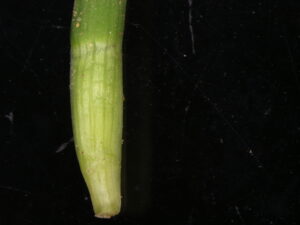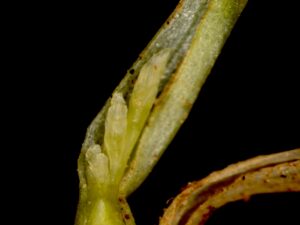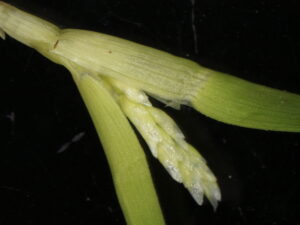Main Content
In weed management on golf courses, annual bluegrass (Poa annua) seedhead (inflorescence) suppression often kicks off the growing season. Plant growth regulators can be used to suppress seedhead production if applications are properly timed. Much like pre-emergence herbicides that are not effective if applied after weed emergence, PGRs are less effective if applied too late.
It is common to make two or three sequential applications of trinexapac-ethyl (i.e., Primo Maxx, T-Nex) + ethephon (i.e., Proxy, Ethephon 2 SL) or ethephon alone in the spring. Timing the first application can be difficult. One method is to make the first application at the first sign of the “boot” stage. Annual bluegrass is considered in boot stage when the stem is swollen, indicating that it contains a seedhead (pictured below).

If the leaf tissue is carefully removed from the stem layer by layer, it will reveal the inflorescense (pictured below), which you can usually see with your naked eye or the aid of a hand lens.


This seedhead will continue to move up the stem, eventually emerging. Once the seedhead emerges from the stem the plant is considered post boot stage. Using the boot stage method to time applications requires careful inspection of several plants at various times during the spring. To predict booth stage on a putting green, it is best to check south facing slopes and higher cut turf, as seedhead emergence in these areas will be ahead of putting greens.
Growing degree-day models have been developed as alternatives to boot stage-based PGR application timings. One model developed by Dr. Ron Calhoun at Michigan State University (gddtracker.net) uses a base temperature of 32 degrees F and a target of 200 to 500 GDD with accumulation beginning February 15th. However, to my knowledge this model has not been validated in the Northeast region. The unusually warm winter may make this model less reliable. On the day this was written, our research farm in North Brunswick has accumulated 40 GDD32 since February 15th. If the weather occurs as predicted, we may reach 200 GDD32 by Sunday February 26th when more seasonal weather returns.
Another GDD model common to the Northeast region uses a base temperature of 50 degrees F and a target accumulation of 50 GDDs beginning February 1st. However, I am not aware of any published literature validating this model in this region. On the day this was written, our research farm in North Brunswick has accumulated 8 GDD50 since February 15th. If the weather occurs as predicted, we may reach 30 GDD50 by Sunday when more seasonal weather returns.
A combination of GDD tracking and scouting for boot stage may be useful to time PGR applications. Scout roughs and bare areas with annual bluegrass for boot stage and seedhead emergence. As we approach the GDD threshold, scout roughs, fairways, and greens more intensely for boot stage and seedhead emergence. Boot stage is typically observed in late March or early April in New Jersey so we are still likely several weeks away. However, if temperatures remain warm it may arrive earlier this year.
Recent research from Dr. Shawn Askew at Virginia Tech has demonstrated efficacy of ethephon applications made just before winter dormancy followed by spring applications of trinexapac-ethyl + ethephon. We have a trial underway at Rutgers to evaluate the efficacy of fall applications in this region in collaboration with Dr. Zane Raudenbush at Ohio State. In addition to validation of this fall application strategy in multiple regions, research to ensure fall or winter applications of ethephon do not increase the potential for annual bluegrass winterkill may be necessary. For more information on Dr. Askew’s research visit http://www.golfdom.com/a-new-key-to-poa-annua-seedhead-suppression/
Fun Fact: Annual bluegrass seed can become viable even if the seedhead is removed from the plant on the same day it is pollinated. Just another reason this weed is so competitive in turfgrass!
Note: Embark (mefluidide) also provides excellent annual bluegrass seedhead suppression when used properly, but it is no longer being manufactured.
We will continue to scout for annual bluegrass seedhead emergence. To share your own observations and for updates from Rutgers, follow @RUturfweeds on Twitter!